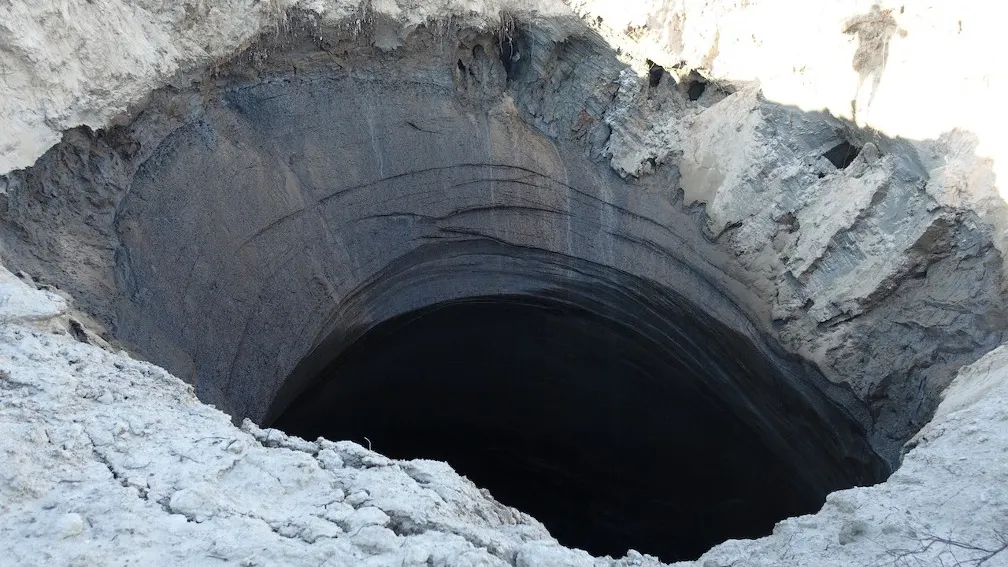0
0
Mysteries of nature. Scientists studied reasons for formation of craters in Yamal
Scientists of Skoltech together with their colleagues from other organizations have been studying a crater on the Yamal Peninsula for more than two years. The crater was formed as a result of gas emission from the permafrost layer. At the time of the discovery the crater was 20 meters deep and the same width. The scientists were able to build models describing possible processes of formation of such craters and having prospects for use in geocryology and research of climate changes. The results of the study supported by the company “Total” are published in two articles in the journal Geosciences.
Permafrost zone, which occupies in total two-thirds of the territory of Russia, is a giant natural reservoir of one of the most powerful greenhouse gases - methane. Scientists are seriously concerned about the threat of escaping of large amounts of methane to the atmosphere in the context of the general warming in the arctic region and the gradual degradation of permafrost due to climate change. It could lead to further aggravation of the global warming.
Methane is able not only be gradually released from cryogenic layers of arctic territories, but also enter the atmosphere in the form of a powerful explosive release. The famous “Yamal Crater”, a giant funnel with the diameter 40 meters discovered in 2014 in 42 kilometers away from Bovanenkovskoye gas field, could have formed that way. Such powerful emissions leave in the truest sense of the word “scars” on the Earth’s surface. The scientists have not yet come to a consensus on sources of gas that cause such phenomena, as it is informed on the website of Skolkovo Institute of Science and Technology.
“Craters in the Arctic are a fairly rare phenomenon that occurs, as a rule, in hard-to-reach areas of the Arctic tundra. Swelling of the surface, which precedes appearing of a gas emission crater, occurs quite quickly, often within 1 to 2 years, and rapid growth of the resulting hillock (pingo) is difficult for registering. Almost all craters were discovered already after their formation. There is only fragmentary evidence of local residents, who say they heard noise or saw smoke and flames. It should also be taken into consideration that craters formed quickly enough, in just 1 to 2 years, turn into lakes, which over time are difficult for distinguishing from ordinary thermokarst lakes in the Arctic tundra”, said Yevgeniy Chuvilin, a leading researcher at the Skoltech Center for Hydrocarbon Recovery.
The group of the scientists of Skoltech examined the crater of gas emission in the floodplain of Yerkuta-Yakha River on the Yamal Peninsula. In the summer of 2017 it was accidentally discovered by biologists, who studied nesting sites of the falcon in the region. According to Yevgeniy Chuvilin, the scientists were very lucky: they were able to reach the little-known Yerkutinsky Crater and study it in the first year since its formation, because the next year it was already filled with water and turned into a lake. The team of Skoltech was probably the only one, who managed to conduct research on Yerkutinsky Crater.
In December 2017, during an expedition to Yamal, the scientists selected samples of frozen rocks, underground ice and water from Yerkutinsky Crater, and six months later they made observations with use of drones. The very low negative value δ13C (the ratio between amounts of stable carbon isotopes 13C and 12C) was found in the samples of underground ice characteristic of biogenic hydrocarbons. At the same time, the ratio of the methane amount to the total number of its homologues - ethane and propane - indicated the possibility of coming of thermogenic gas from deeper layers.
Being based on the results of the research, the scientists built a model of formation of Yerkutinsky Crater, which had formed in place of one of dried lakes left over from a dead arm of a river - the former paleo-riverbed of the Yerkuta-Yakha River. Previously a talik could have been under the lake: a section of unfrozen gas-saturated rock, which after drying out of the lake began to freeze gradually on all sides, as a result of what strong tension was created in it, what subsequently led to the powerful explosion.
“Formation of a gas emission crater in permafrost is a little-studied and practically non-described permafrost-geological process, which is an explosive release of a mixture consisting of rocks, ice, water and gas. Some researchers call this process cryovolcanism. Such natural processes with formation of large funnels can pose a danger to human life in the Arctic. In this regard, there is the necessity to forecast such processes on the basis of results of studying of gas sources, primarily methane, mechanisms of their accumulation in the upper permafrost horizons and conditions for appearing of explosive gas emissions. Such emissions can also contribute to increase in greenhouse gases in the atmosphere. On the other hand, climate change may be one of the causes leading to appearing of craters. However, study of this interrelation and mutual influence is still ahead for researchers”, said Yevgeniy Chuvilin.
The research was conducted with participation of the French energy company Total, the department on science and innovations of Yamal-Nenets Autonomous Okrug and the scientific center for study of the Arctic.
0
0
Теги:
